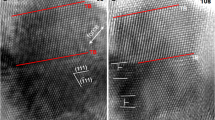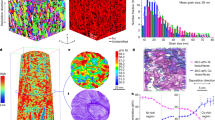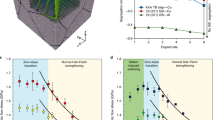Abstract
In conventional metals, there is plenty of space for dislocations—line defects whose motion results in permanent material deformation—to multiply, so that the metal strengths are controlled by dislocation interactions with grain boundaries1,2 and other obstacles3,4. For nanostructured materials, in contrast, dislocation multiplication is severely confined by the nanometre-scale geometries so that continued plasticity can be expected to be source-controlled. Nano-grained polycrystalline materials were found to be strong but brittle5,6,7,8,9, because both nucleation and motion of dislocations are effectively suppressed by the nanoscale crystallites. Here we report a dislocation-nucleation-controlled mechanism in nano-twinned metals10,11 in which there are plenty of dislocation nucleation sites but dislocation motion is not confined. We show that dislocation nucleation governs the strength of such materials, resulting in their softening below a critical twin thickness. Large-scale molecular dynamics simulations and a kinetic theory of dislocation nucleation in nano-twinned metals show that there exists a transition in deformation mechanism, occurring at a critical twin-boundary spacing for which strength is maximized. At this point, the classical Hall–Petch type of strengthening due to dislocation pile-up and cutting through twin planes switches to a dislocation-nucleation-controlled softening mechanism with twin-boundary migration resulting from nucleation and motion of partial dislocations parallel to the twin planes. Most previous studies12,13 did not consider a sufficient range of twin thickness and therefore missed this strength-softening regime. The simulations indicate that the critical twin-boundary spacing for the onset of softening in nano-twinned copper and the maximum strength depend on the grain size: the smaller the grain size, the smaller the critical twin-boundary spacing, and the higher the maximum strength of the material.
This is a preview of subscription content, access via your institution
Access options
Subscribe to this journal
Receive 51 print issues and online access
$199.00 per year
only $3.90 per issue
Buy this article
- Purchase on Springer Link
- Instant access to full article PDF
Prices may be subject to local taxes which are calculated during checkout




Similar content being viewed by others
References
Hall, E. O. The deformation and ageing of mild steel: III. Discussion of results. Proc. Phys. Soc. Lond. B 64, 747–753 (1951)
Petch, N. J. The cleavage strength of polycrystals. J. Iron Steel Inst. 174, 25–28 (1953)
Hirth, J. P. & Lothe, J. Theory of Dislocations 2nd edn, 764–790 (John Wiley and Sons, 1982)
Devincre, B., Hoc, T. & Kubin, L. Dislocation mean free paths and strain hardening of crystals. Science 320, 1745–1748 (2008)
Meyers, M. A., Mishra, A. & Benson, D. J. Mechanical properties of nanocrystalline materials. Prog. Mater. Sci. 51, 427–556 (2006)
Yip, S. Nanocrystals: the strongest size. Nature 391, 532–533 (1998)
Schiøtz, J., Di Tolla, F. D. & Jacobsen, K. W. Softening of nanocrystalline metals at very small grain sizes. Nature 391, 561–563 (1998)
Schiøtz, J. & Jacobsen, K. W. A maximum in the strength of nanocrystalline copper. Science 301, 1357–1359 (2003)
Wolf, D., Yamakov, V., Phillpot, S. R., Mukherjee, A. K. & Gleiter, H. Deformation of nanocrystalline materials by molecular-dynamics simulation: relationship to experiments? Acta Mater. 53, 1–40 (2005)
Lu, L., Shen, Y., Chen, X., Qian, L. & Lu, K. Ultrahigh strength and high electrical conductivity in copper. Science 304, 422–426 (2004)
Lu, L., Chen, X., Huang, X. & Lu, K. Revealing the maximum strength in nano-twinned copper. Science 323, 607–610 (2009)
Cao, A. J. & Wei, Y. G. Molecular dynamics simulation of plastic deformation of nanotwinned copper. J. Appl. Phys. 102, 083511 (2007)
Shabib, I. & Miller, R. E. Deformation characteristics and stress-strain response of nanotwinned copper via molecular dynamics simulation. Acta Mater. 57, 4364–4373 (2009)
Chokshi, A. H., Rosen, A., Karch, J. & Gleiter, H. On the validity of the Hall-Petch relationship in nanocrystalline materials. Scr. Metall. Mater. 23, 1679–1684 (1989)
Kumar, K. S., Suresh, S., Chisholm, M. F., Horton, J. A. & Wang, P. Deformation of electrodeposited nanocrystalline nickel. Acta Mater. 51, 387–405 (2003)
Shan, Z. W. et al. Grain boundary-mediated plasticity in nanocrystalline nickel. Science 305, 654–657 (2004)
Van Swygenhoven, H., Spaczer, M., Caro, A. & Farkas, D. Competing plastic deformation mechanisms in nanophase metals. Phys. Rev. B 60, 22–25 (1999)
Yamakov, V., Wolf, D., Phillpot, S. R. & Gleiter, H. Deformation twinning in nanocrystalline Al by molecular-dynamics simulation. Acta Mater. 50, 5005–5020 (2002)
Uchic, M. D., Dimiduk, D. M., Florando, J. N. & Nix, W. D. Sample dimensions influence strength and crystal plasticity. Science 305, 986–989 (2004)
Greer, J. R., Oliver, W. C. & Nix, W. D. Size dependence of mechanical properties of gold at the micron scale in the absence of strain gradients. Acta Mater. 53, 1821–1830 (2005)
Shan, Z. W., Mishra, R. K., Syed Asif, S. A., Warren, O. L. & Minor, A. M. Mechanical annealing and source-limited deformation in submicrometre-diameter Ni crystals. Nature Mater. 7, 115–119 (2007)
Hemker, K. J. & Nix, W. D. Nanoscale deformation: seeing is believing. Nature Mater. 7, 97–98 (2008)
Frøseth, A., Van Swygenhoven, H. & Derlet, P. M. The influence of twins on the mechanical properties of nc-Al. Acta Mater. 52, 2259–2268 (2004)
Zhu, T., Li, J., Samanta, A., Kim, H. G. & Suresh, S. Interfacial plasticity governs strain rate sensitivity and ductility in nanostructured metals. Proc. Natl Acad. Sci. USA 104, 3031–3036 (2007)
Christian, J. W. & Mahajan, S. Deformation twinning. Prog. Mater. Sci. 39, 1–157 (1995)
Van Swygenhoven, H., Derlet, P. M. & Froseth, A. G. Stacking fault energies and slip in nanocrystalline metals. Nature Mater. 3, 399–403 (2004)
Wang, Y. B., Sui, M. L. & Ma, E. In situ observation of twin boundary migration in copper with nanoscale twins during tensile deformation. Phil. Mag. Lett. 87, 935–942 (2007)
Kulkarni, Y. & Asaro, R. J. Are some nano-twinned fcc metals optimal for strength, ductility and grain stability? Acta Mater. 57, 4835–4844 (2009)
Mishin, Y., Mehl, M. J., Papaconstantopoulos, D. A., Voter, A. F. & Kress, J. D. Structural stability and lattice defects in copper: ab initio, tight-binding, and embedded-atom calculations. Phys. Rev. B 63, 224106 (2001)
Nose, S. A. A unified formulation of the constant temperature molecular dynamics methods. J. Chem. Phys. 81, 511–519 (1984)
Tuckerman, M., Berne, B. J. & Mantyna, G. J. Reversible multiple time scale molecular dynamics. J. Chem. Phys. 97, 1990–2001 (1992)
Van Swygenhoven, H., Farkas, D. & Caro, A. Grain-boundary structures in polycrystalline metals at the nanoscale. Phys. Rev. B 62, 831–838 (2000)
Acknowledgements
X.L. and H.G. acknowledge financial support by the NSF through the MRSEC Program (award number DMR-0520651) and grant CMMI-0758535 at Brown University. The simulations reported were performed on NSF TeraGrid resources provided by NICS under MSS090036 (H.G.) and DMR090083 (Y.W.), with additional support from the Computational Mechanics Research Facility at Brown University and the Alabama Supercomputer Center. Helpful discussions with J. D. Embury, W. D. Nix, H. Mughrabi, M. A. Meyers and R. Taylor are gratefully acknowledged. L.L. and K.L. acknowledge financial support by the NSFC (grant numbers 50621091, 50725103 and 50890171) and the MOST of China (grant number 2005CB623604).
Author Contributions All authors contributed equally to this work. H.G., K.L. and L.L. conceived the project. X.L. and Y.W. performed molecular dynamics simulations. All authors analysed data, developed the model, discussed the results and wrote the paper.
Author information
Authors and Affiliations
Corresponding authors
Ethics declarations
Competing interests
The authors declare no competing financial interests.
Supplementary information
Supplementary Information
This file contains Supplementary Figures S1-S9, Supplementary Discussions 1-4, Supplementary References and legends for Supplementary Movies 1-6. (PDF 4338 kb)
Supplementary Movie 1
This movie file contains an animation of nano-twinned Cu with grain size d=10nm and twin boundary spacing λ=0.63nm under uniaxial tension (see Supplementary Information file for full legend). (MOV 7750 kb)
Supplementary Movie 2
Animation of nano-twinned Cu with grain size d=10nm and twin boundary spacing λ=3.75nm under uniaxial tension (see Supplementary Information file for full legend). (MOV 7792 kb)
Supplementary Movie 3
This movie file contains an animation of nano-twinned Cu with grain size d=20nm and twin boundary spacing λ=0.83nm under uniaxial tension (see Supplementary Information file for full legend). (MOV 5299 kb)
Supplementary Movie 4
This movie file contains an animation of nano-twinned Cu with grain size d=20nm and twin boundary spacing λ=6.25nm under uniaxial tension (see Supplementary Information file for full legend). (MOV 5331 kb)
Supplementary Movie 5
This movie file contains an animation of evolution of dislocation structures within one grain of nano-twinned Cu with grain size d=20nm and twin boundary spacing λ=0.83nm under uniaxial tension (see Supplementary Information file for full legend). (MOV 6208 kb)
Supplementary Movie 6
This movie file contains an animation of evolution of dislocation structures within one grain of nano-twinned Cu with grain size d=20nm and twin boundary spacing λ=6.25nm under uniaxial tension (see Supplementary Information file for full legend). (MOV 4288 kb)
Rights and permissions
About this article
Cite this article
Li, X., Wei, Y., Lu, L. et al. Dislocation nucleation governed softening and maximum strength in nano-twinned metals. Nature 464, 877–880 (2010). https://doi.org/10.1038/nature08929
Received:
Accepted:
Published:
Issue Date:
DOI: https://doi.org/10.1038/nature08929
This article is cited by
-
Molecular dynamics simulation of Cr–O–C discrete nuclei to reduce the binding force of nanocrystalline Cu/Ni complexes
Journal of Materials Science (2024)
-
Strengthening Effect of Decreased Dislocation Density After Annealing in Pure Aluminum or Copper
Metals and Materials International (2024)
-
Strengthening mechanisms in heterostructured copper films with highly (220)-oriented vertical nanotwins
Acta Mechanica Sinica (2024)
-
Contribution of boundary non-stoichiometry to the lower-temperature plasticity in high-pressure sintered boron carbide
Nature Communications (2023)
-
Multiple elastic shock waves in cubic single crystals
Shock Waves (2023)
Comments
By submitting a comment you agree to abide by our Terms and Community Guidelines. If you find something abusive or that does not comply with our terms or guidelines please flag it as inappropriate.



